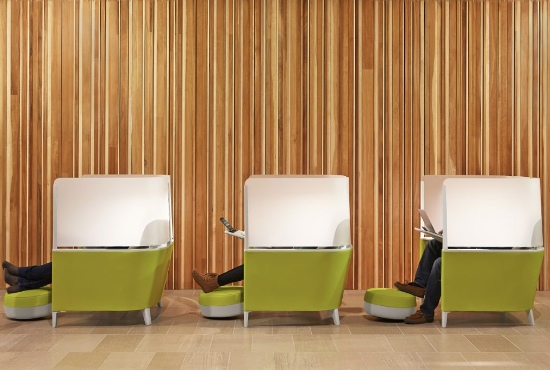Open floor plans certainly have many advantages.
They provide a business center or coworking space with an abundance of space to be used for collaboration and networking. They also provide a sense of openness and airiness when compared to the closed box-in feeling of more traditional spaces.
Yet, as attractive and popular as open plan offices are, there are plenty of workers who find themselves intimidated by or just turned off by their sheer size. And, it is well documented that noise levels can be a problem.
The steady backlash against open office plans has resulted in niche opportunities within the office furniture industry to provide a method of gaining privacy in the midst of large bustling open coworking spaces and business centers.
One internationally known office furniture supplier, Steelcase, has taken the concept of building out privacy in large open offices to a new level. They call it a ‘worklounge’ and it’s gaining popularity for its design, mobility and lightweight look and feel.
Their latest offering, the Brody WorkLounge was the outgrowth of an extensive research study conducted by Steelcase on how the human brain functions. The study revealed some interesting and useful intelligence about how we multi-task and even how long it takes the brain to re-focus after we are interrupted. It takes 23 minutes, by the way; a surprising fact in itself.
The lead designer on the project, Markus McKenna, worked with Steelcase to construct what McKenna refers to as a “cocoon-like space”; a three sided set of privacy screens that work together to obstruct peripheral vision and help block out the sound and vision of people traffic around it. The lounges have their own light source and are ergonomically built to embrace the body in what McKenna terms an “alert recline” position that supports the head and neck, helping to prevent shoulder, eye and neck strain.
There is a lot more to the Brody WorkLounge, and you can read all the details in a recent blog by Slate.
Can coworking and business center owners and operators use these work lounges to boast a “best of both worlds” experience to their clients? Or will offices continue to rely upon private alcoves and small office build outs to satisfy the need for peace and quiet? Time will tell. In the meantime, however, it may make sense for operators to have a few work lounges available for those workers who crave a quiet cocoon of their own.


 Dr. Gleb Tsipursky – The Office Whisperer
Dr. Gleb Tsipursky – The Office Whisperer Nirit Cohen – WorkFutures
Nirit Cohen – WorkFutures Angela Howard – Culture Expert
Angela Howard – Culture Expert Drew Jones – Design & Innovation
Drew Jones – Design & Innovation Jonathan Price – CRE & Flex Expert
Jonathan Price – CRE & Flex Expert











